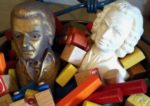Guest Post: Teaching Students From Different Backgrounds, Neeki Bey
Those of you who know me, know that I am totally against, what my friend calls, “drive by arts experiences”. These experiences can encompass a range of genres; the Chopin Waltz, the 12 Bar Blues piece, The “by ear” piece, Sakura… You get the picture. I also believe in respecting a student’s background and finding ways to relate music to each student’s unique point of view. Well, in this post, Neeki Bey encourages us to add to our pedagogical toolbox and deepen our own and our students’ musical experiences. Read on!

One of the most beautiful aspects of music teaching is that each student is different. Fortunately, there is not a shortage of diverse incredible, readily available music at all levels. Too often though, as teachers, we fail to explore the rich diversity of music available, instead repeating what we’ve done in the past and making our pupils conform. This is a huge missed opportunity.
In the late 1980’s choral teachers had a dilemma: Should they proceed only singing the classical, anthems and traditional choral music of the past or move forward and incorporate popular songs, spirituals, and world music?
I was very fortunate my teachers chose the latter. I benefited from the rise of ethnomusicological and compositional efforts moving into the 90’s that endeavored beyond European music. This general trend in choral music continues today, as now music influenced by and from different cultures is a standard part of the repertoire. Choristers and choral music have never been the same!
Teachers and publishers were responding in part to a new body of students who loved music, loved singing and brought with them diverse backgrounds. These same diverse students are studying piano with you and me today. Now, we are challenged to ask ourselves: Are we facilitating positive musical experiences for all of our students, regardless of their background or are we imposing a “my way or the highway” approach?
To be clear, I, like you, have spent years honing my craft and developing my piano pedagogical skills, so I’m not suggesting you throw out your book. Let’s add to it!
Here are some ideas to get you started:
Find out what music excites your students.
What music do they listen to? What music is important to their culture? What music do they find interesting that may not be what their friends are listening to?
There’s a lot we can gather from asking questions and listening to our students. Keeping an open mind and genuine interest in your students’ musical thoughts, through conversation, can help develop student buy-in and trust.
Incorporate a time of listening to different styles of music in your lessons where students can share music and be exposed to/relate with different sounds that you present.
Music is an aural, experiential art and in the process of listening, you and your student may be the better for it.
Does your student enjoy fun rhythmic music, slower music with beautiful melodies, minor or major songs, patterned pieces, etc…?
Relate pieces in your current teaching materials to sounds or feelings your student likes. This is a great way to start building a musical bridge with your students.
Explore different music learning techniques to fully engage your student’s learning potential.
I’m to this day not quite sure why with music, an aural art, teachers are afraid of students who use their ears to learn music. I think this “aural-phobia” is a lose-lose for both teachers and students. I recently completed a collection of arrangements of popular African music for piano. The music series, Piano Accents, is dedicated to presenting genuine world music in as close to its original form as possible. African music by nature is energetic, rhythmic and exciting, driven by its syncopation and inviting melodies.
My students, from the most advanced to the most rhythmically challenged, have excelled with even very syncopated pieces by making use of the provided multi-tempo accompaniment tracks. Yes, I encourage them to learn by listening and they thrive! Let’s be clear, students using their ears to learn certain pieces are not diminishing their musical journey rather, they are enhancing it.
We have to be mindful as teachers of not clouding our student’s perceptions with our fears. Furthermore, much of the music our students listen to today is syncopated and with the right techniques, you’ll find that, for our students, the journey of learning this and other music can be very rewarding.
Make your lessons interesting musical experiences.
Within your lesson plan, ensure that there is emotional and experiential space for your students from different backgrounds to feel enjoyment through the music they make. If you don’t get to an item in your lesson this week because your student had a breakthrough, don’t worry about it. Before moving on, stop and allow your student time to relish that moment.
Some of the most personally and professionally fulfilling moments in my life have been experiencing my students connect with the piano in ways they didn’t know possible. I challenge you, with your students from all backgrounds, to excitedly take the musical journey with them and help make the piano come alive.
Neeki Bey, a graduate of Morehouse College and Southern Methodist University, maintains an active schedule as a composer, teacher, performer and director. His new series of world music for the piano, Piano Accents, features the music of Africa with new releases of Bollywood coming in early 2012 and South American music (with Gail Fischler) coming in Spring 2012.
A side note: Here is a bit of advice from my friend Joanna Xylas in Bristol England on working with first generation families where parents don’t speak or understand English well.
I am an American of Greek descent now living in one of the most multi-cultural areas of Bristol, England. As a result, I teach students from many different parts of the world and who speak a multitude of languages at home. Some of the countries my piano families come from include India, Sri Lanka, Iraq, France, Germany and China. All the children speak fluent English, however, their parents may have some difficulties in comprehension. Nonetheless, we are able to communicate a strong team effort in support of their children’s music education. I am truly blessed with the level of enthusiasm the students possess and the high level of encouragement their parents provide them.
Joanna finds that such parents can be put at ease by enrolling students in programs such as ABRSM. Since the parents often have never studied a musical instrument, this provides a framework for them to gauge their child’s progress and to provide the right support and encouragement.



It’s also the best way to welcome the students’ individual cultures and experiences. If you nurture their improvving and writing, what else will appear on the page but their culture? Even arranging pieces with a new “feel” to them will do that. I’m a pretty firm believe that every form of music can be played well on every instrument.
Hi Janis,
I totally agree with your point. I think there is a mindset in education sometimes where the teacher feels as if he or she must be the complete authority and therefore not expose any vulnerabilities. Well my favorite educators, and people in general, are those who are continually learning. I think there can be some pretty neat opportunities when we allow ourselves continued growth, even sometimes in the faces of our students.
“Let’s be clear, students using their ears to learn certain pieces are not diminishing their musical journey rather, they are enhancing it.”
And students that never learn to use their ears will never be able to play or write down their own musical ideas. This is a big complaint of mine — if you turn out a student who is mute on their instrument without a piece of paper in front of them, you have done them a great disservice. Sheet music and musical literacy is vital. So is the ability to either speak “off the cuff” on your instrument through improv, or to work out and write down your own musical ideas, even if slowly. Both are ideal, but either is good. Mozart didn’t play his music by going out and buying a Schirmer compendium of Mozart’s greatest works! He sat down with nothing on the music desk and plonked out a couple notes to see where they were headed, and went from there. By ear, obviously.
But not only does the current pedagogy teach the student the teacher’s fears, but their limitations as well. Most music teachers, if they had to give a student guidance in improv or writing, couldn’t teach it because they couldn’t do it themselves. This is a problem.